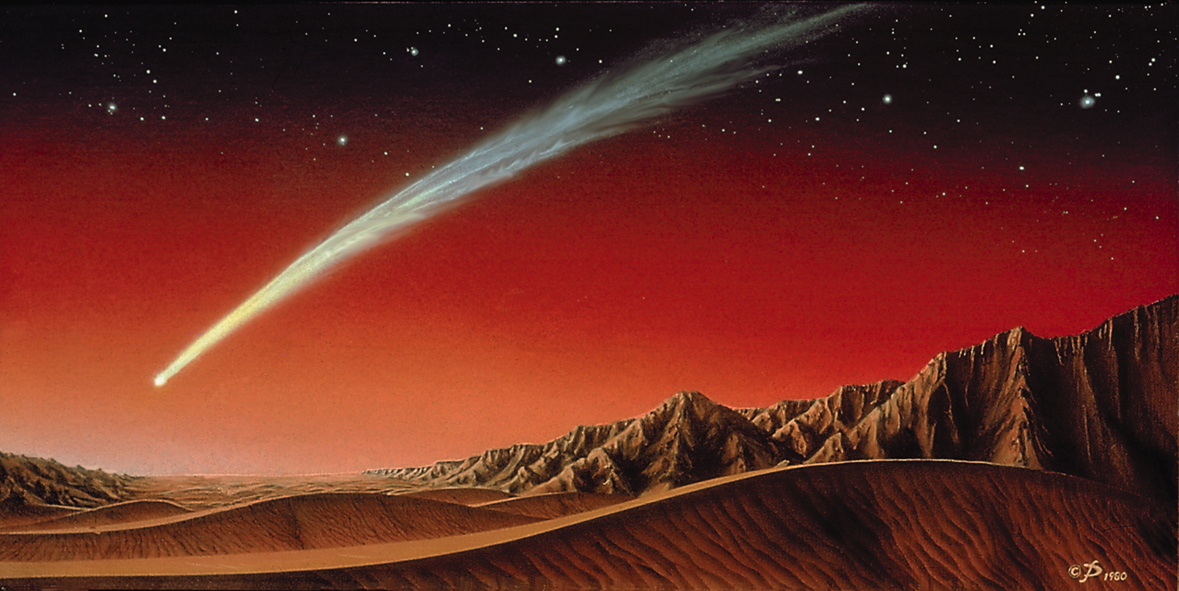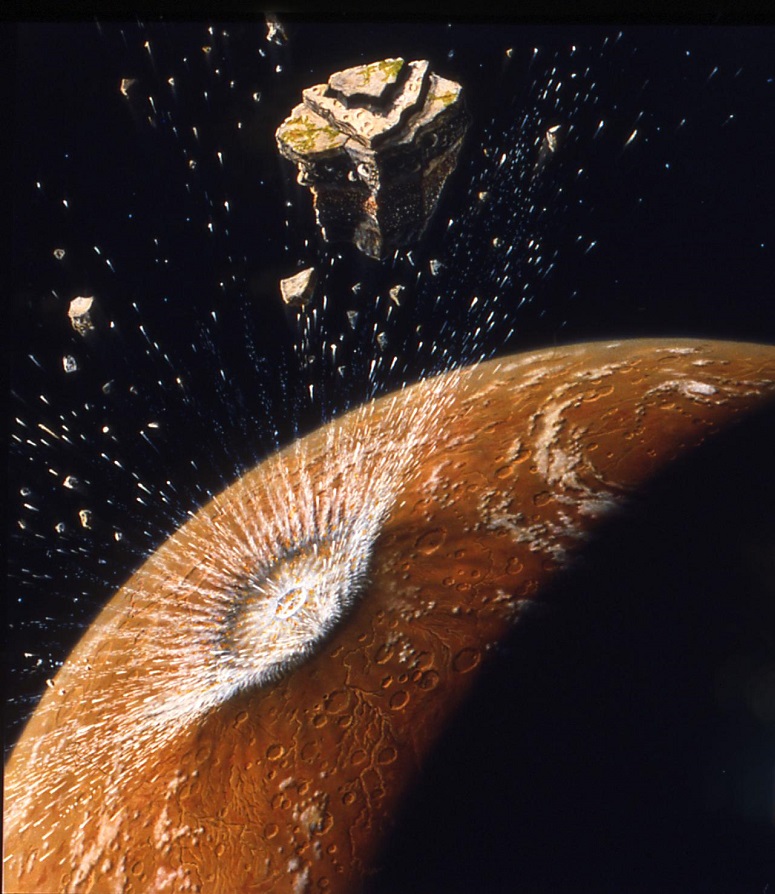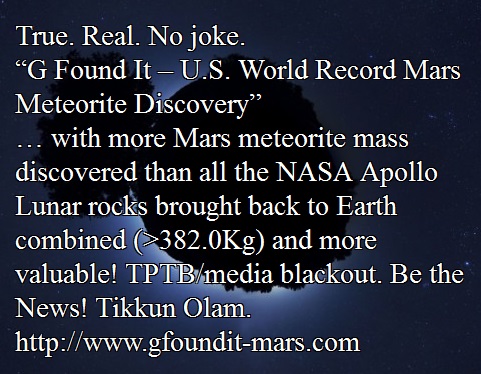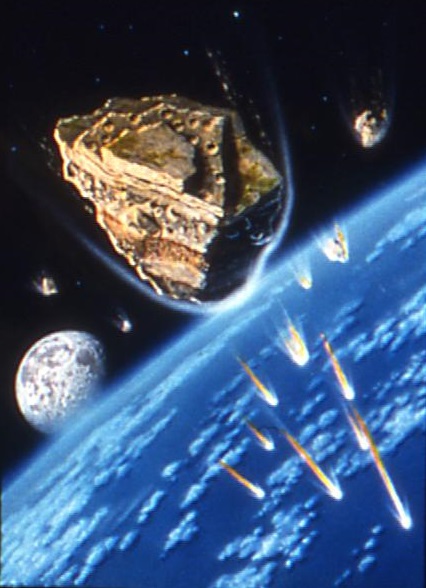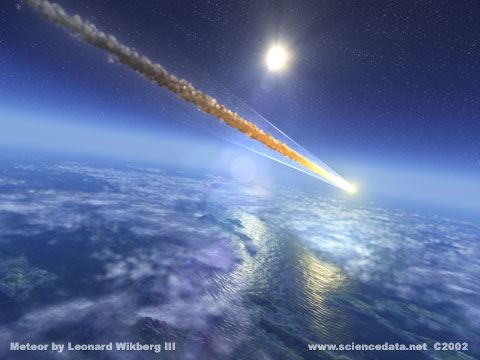
**Caution: one must wear fire proof asbestos underwear when reading these posts and have a strong back-bone when visiting this well known meteoritics community discussion list. Many people involved with meteorites from around the world are members or simply read the many discussions and posts out of interest and never join. I lurked and read the list for many years too before finally joining. The many different members world-wide are meteorite hunters, collectors, dealers, and scientists within the field of meteoritics, cosmochemistry, astrogeology, space science, and Cosmology. There are massive amounts of great information and great discussions usually, but there are also some big egos, but not all and not everyone, only a few. As a result very nasty exchanges can occur on the list, hence the need for asbestos underwear and a very strong backbone. Lots of "Doubting Thomases" who aren't willing to discuss the empirical evidences and debate honestly regarding my discovery the U.S. World Record Mars Meteorite Discovery. Sad. Very sad.
So if I'm blocked from the Meteorite List community, (I have only been very respectful under a great deal of personal attacks, criticisms, and name calling toward me), I will respond here with my rebuttal since apparently freedom of speech to discuss an incredible scientific U.S. World Record Mars Meteorite Discovery (USWRMMD) and to debate the empirical evidence for the discovery is being suppressed by certain members of the Meteorite List community. That my friend is the definition of censorship and absolutely contrary to science. Let the facts speak for themselves. Discussions of my discovery can not be more on target for the Meteorite List. You might even learn something about meteoritics, the field of meteorite scientific study, that so many of us are absolutely enthralled with.
The posts are listed chronologically, with the most current on top and the oldest related posts on the bottom. Scroll to the bottom of the page to get to the oldest post related to the USWRMMD.
I will respond to the critiques and criticisms from Cosmochemist grad student Jason Utas from UCLA currently working on his PhD. My rebuttal and comments to Jason will be in green bold italics . I do appreciate that Jason took the time to respond via a private email that he sent to me and then in turn I sent back to him in kind. I did not post it publicly. Another Meteorite List member "Bigjohn Shea," did that inappropriately breaking the rules of the Meteorite List. Like I said, you've got to wear asbestos underwear to be active on the list. But now that it's out in the open and public I feel it's necessary to respond to Jason's criticisms and to do so publicly.
The Rules of the Meteorite List:
http://meteoritecentral.com/mailing-list.html#RULES
Like the old adage says ...
"First they ignore you. Then they laugh at you. Then they attack you. Then you win."
--Mohandas Gandhi
Useful Resources for optical mineralogy and impact shock metamorphism studies that I commonly use (many more in the body of the rebuttal) ...
Optical Mineralogy Resources:
Introduction to Optical Mineralogy and an CD Atlas of Minerals in Thin Section, by William D. Nesse
Teaching Mineralogy Topical Resources (great resource page):
http://serc.carleton.edu/NAGTWorkshops/mineralogy/index.html
Teaching Mineralogy Topical Resources (great resource page): Optical Mineralogy and Petrography
http://serc.carleton.edu/NAGTWorkshops/mineralogy/optical_mineralogy_petrography.html
Smith College Petrographic Data Files:
http://www.science.smith.edu/geosciences/petrology/petrography/mineral_list.html
http://leggeo.unc.edu/Petunia/IgMetAtlas/minerals/minerals.html
Table of Contents: Some Fundamental Properties of Minerals in Thin Section
http://neo.eps.utk.edu/310/Atlas/table-of-contents.html
Impact Shock Metamorphism and other useful meteorite resources:
CH 4 Shock Metamorphic effects in Rocks and Minerals
Deformation Microstructures and Mechanisms in Minerals and Rocks
By Tom Blenkinsop, (it has a whole unit on Shock-induced microstructures and metamorphism)
IMPACT CRATERING: AN OVERVIEW OF MINERALOGICAL AND GEOCHEMICAL ASPECTS
Shock effects in plagioclase feldspar from the Mistastin Lake impact structure, Canada
Field Guide to Meteors and Meteorites, by O. Richard Norton and Lawrence A. Chitwood
BASIC SCIENCE STUDIES II: IMPACT CRATERING
http://fas.org/irp/imint/docs/rst/Sect18/Sect18_1.html
http://fas.org/irp/imint/docs/rst/Sect18/Sect18_3.html
PhD Randy L. Korotev's website on Lunar Meteorites:
http://meteorites.wustl.edu/lunar/moon_meteorites.htm
PhD Tony Irving's website on Martian Meteorites:
http://imca.cc/mars/martian-meteorites.htm
United States Meteorite Impact Craters: Planar Deformation Features in Quartz
http://impactcraters.us/crater_identification/pdfs_and_pfs
Shock Metamorphism Page (thanks to Jason Utas, hadn't seen this page before)
http://www.impact-structures.com/shock-metamorphism-page/
Shock Metamorphism of some minerals: Basic introduction and microstructural observations
http://www.geology.cz/bulletin/fulltext/03langenhorstfinal.pdf
Origin of “toasted” quartz in terrestrial impact structures
The origin of "Toasted" Quartz in Impactites Revisited
http://www.lpi.usra.edu/meetings/lpsc2009/pdf/1751.pdf
Jason Utas's private email to Glyn Howard (that was made public on the Meteorite List, but not by Glyn Howard):
> From: jason utas <jasonu...@gmail.com>
> Sent: Monday, April 25, 2016 7:11 PM
> To: Ann Cain; Art Jones; Impactika; Galactic Stone; Michael
Mulgrew; Bigjohn
> Shea
> Subject: WR Gallery Delay – U.S. World Record Mars Meteorite
Discovery
>
> Glyn,
> You have derided a number of fairly educated and experienced
list-members.
I did not. I have been very courteous after being personally attacked, made fun of, and called many inappropriate names, and even sworn at using fowl language on the Meteorite List. I have not ever responded in kind. I explained that unprofessional behavior can and does sometimes happen in science, since scientists are human, and I gave the link that validates that this does indeed happen in science at times, unfortunately. There are many infamous and unfortunate histories within science that bear this out. To say this doesn't happen, then you don't know the history of science and you are very nieve.
Watch: "NOVA -- Newton's Dark Secrets" for some historical perspective concerning Sir Robert Hooke vs. Sir Isaac Newton illustrating this very kind of unethical behavior on Sir Robert Hooke's part toward Sir Isaac Newton ... here.
"Contrary to their public image,
scientists are normal, flawed human beings. They are as capable
of prejudice, covetousness, pride, deceitfulness, etc., as anyone."
-- David Weatherall, "Conduct Unbecoming," American
Scientist (Vol.93, January-February 2005), p.73
http://www.americanscientist.org/bookshelf/pub/conduct-unbecoming
I explained a little of the history and circumstances behind this discovery. I have suffered unethical, unprofessional, jealousy and envy and have been given misinformation/disinformation purposefully, and had to deal with gate-keeping and stone-walling behaviors. It was only a few very well known meteoriticists who did this, and they will stay anonymous. As I explained, it isn't my purpose to hurt anyone professionally. Once my study is done and complete to a point where the empirical evidence is overwhelming and the criticisms are addressed, a heart felt apology from these few individuals and acknowledgement that they were wrong from the very beginning will be enough. I'm a very forgiving person. We all make mistakes. Though some people do indeed make purposeful "mistakes."
Likewise, I worked with many geologists, meteoriticists, and technicians who were very professional through and through, and who also have given great advice and help at key moments in my discovery. I will in time give all of these individuals due credit for all those involved when the entire story can become public.
For a more detailed summary of the background history of this discovery ...
> As a studying cosmochemistry PhD with
about two decades' worth of experience
> in meteorites, I will list some facts plainly.
>
> I have looked over the evidence you offer on your websites.
>
Thanks for taking the time to do so. Some of your science and evidence criticisms that you have made have actually been helpful. Thank you.
I'm a science teacher. I've been teaching for 20+ years. I have a strong background in the Earth Sciences and Physics. I've been an avid element, mineral, and rock collector since my youth. But I find now that it is a very keen interest of mine, since I have been into meteoritics for nearly 15 years. Lots to learn. Many people come into meteoritics, astrogeology, cosmochemistry, astrobiology, and cosmology from many different fields of study. It's all very multi-disciplinary. That is a big reason I like the study of meteorites so much; it pulls all of my many interests that I have all-together. Yes, I have made a few small mistakes, however these small mistakes do not change the final outcome and conclusion, and the overall fact that I am correct. The mistakes I will correct. Thank you for pushing me to do so, but I don't think that was your original intention.
I will try to ignore your personal jabs, and ad hominem attacks, and I will not respond in kind.
However, your counter arguments are all over the place. Why not address it in a logical flow and order as it was presented and then do so completely? First address the megascopic field evidence, then the macroscopic evidence, then the microscopic evidence/the Shock Stage evidence, then the petrology and geochemistry evidences, and then the Parent Body evidence. There is a logical order to the evidence given. To try to shoot holes into the empirical evidences and arguments in random shotgun style all over the place and completely out of order is difficult to follow and is hap-hazard, and very confusing. Perhaps that was your intention? But I will try.
*You ignore the in-the-field megascopic evidence, but that's understandable, since I didn't give many details for obvious reasons, but it's undeniable. One day the world will know the entire story.
*I will provide more macroscopic up-close photographic 3D stereogram evidences for the shape of the meteorites, fusion crusts and other macroscopic features that I mention as well, as I can get to it. Also I can add additional macro-evidences such as the (over-all) hardness of the meteorite samples and this is a very, very important discussion as you'll see. Also densities. Check out the background story and the issue of hardness is very telling.
*The microscopic/impact shock metamorphism, you have some valid criticisms and I have listened and some problems I had, I now know the answer to. Thank you for pushing me. Optical mineralogy is a science and an art for sure, very qualitative, and hard to get really good at, as well as the identification of impact shock metamorphism. But I'm learning it and I'm doing it. It's one of the reasons why some geology departments are losing optical mineralogy courses, and relying more on electron micro-probes, EMPA. That's a shame. I really enjoy it, and I realize I'm not where I want to be yet. Much more to learn. I will get there. I will add more images at the microscopic level and overall views of the complete thin-sections in PPL, XPL, and incident reflected light. I should have posted these images from the beginning. I will also compare my thin-section images to known Mars meteorite thin-sections from the text, "A Color Atlas of Meteorites in Thin Section." A very important comparison will be made and it will be hard to ignore or refute the facts. Bright shiny FeOs and Sulfides in the matrix are often ubiqitous to Mars meteorites, as are mine, as are all the Mars meteorite fragments found in my discovery.
*The petrology geochemsitry data from whole rock oxide tests is what it is, quantitative and empirical. You really didn't argue that. Tried to but not really.
*Likewise the Parent Body quantitative empirical evidences using the same geochemistry data, you didn't argue that either. Tried to discussing the "Michel-Levy Method" but you didn't succeed. Many PB tests using the geochemistry data were done and they all prove the PB is Mars. You didn't argue this but you ignored it. Telling.
So let me address your criticisms and concerns one by one, treating it like a peer review to some degree ...
I would like to say when all is said and done this is definitely going to turn into another example of a David vs. Goliath like event, and/or a contemporary example like one of my heroes John Muir vs. CA State head geologist Josiah Whitney. At the conclusion of the matters, the underdog won in the end.
https://en.wikipedia.org/wiki/John_Muir#Geological_studies_and_theories
> You note "undulose extinction in
quartz" as evidence that your samples have
> been shocked. But undulatory extinction is common in terrestrial
quartz --
> and not due to shock. See
> here<https://en.wikipedia.org/wiki/Undulose_extinction>
and
> here<https://www.youtube.com/watch?v=HpTENXNj8es>.
Note that this is a very
> common attribute of quartz; most rocks contain some quartz
that exhibits
> undulatory extinction in XPL. Anyone who had picked up a
book on petrology
> would have seen this covered in the first or second chapter.
>
That is true, undulose extinction does occur in some terrestrial metamorphism within quartz grains here on Earth, I didn't say that it didn't. But you are misreading the shock stage table that I used. There are many shock stage tables out there as you are well aware. I will post other shock stage tables below for comparison purposes and their usefulness.
Undulose extinction does also occur due to impact shock metamorphism in quartz at shock level 2 and less, as the table I used indicates. Undulose extinction within olivine begins at shock level 3. There is some overlap of course. Also undulose extinction can also occur in plagioclase. You have to know that in impact shock metamorphism within the country rock of impact craters (the target material) and/or within meteorites due to the original impactor that ejected them from the parent body, that you do not have uniform shock levels throughout all grains throughout the whole country rock specimen (target material) or meteorite. Impact shock metamorphism effects can vary throughout a specimen. There can be many higher shock level impact effects in the grains of a specimen and yet many lower shock level effects remain throughout grains in the matrix of the same specimen, since shock cause and its effects can pass through the rock or meteorite unevenly. My meteorites show this clearly. There can be a grain with high level shock indicators adjacent to a grain with low level shock indicators or even none at all.
This research paper within the first paragraphs describes these effects very well ...
Shock Effects in Meteorites, by Thomas G. Sharp and Paul S. DeCarli
http://www.lpi.usra.edu/books/MESSII/9040.pdf
Also you are clearly ignoring the fact that the quartz grain that I'm using to demonstrate "textbook" undulose extinction due to impact shock metamorphism in GSA also indicates planar fractures (PFs), planar deformation features (PDFs), decorative PDFs, toasting of quartz, shock melt veins and pockets, and very slight mosaicism, and is also surrounded by an impact shock metamorphosed diapletic glass matrix that shows extinction in all directions with very small inclusions of birefrigent cryptocrystalline mineral grains. Remember, diapletic glass is not all or nothing but a gradient. See "Shock Effects in Meteorites" above. Also see the text, "A Color Atlas of Meteorites in Thin Section," by PhD Dante Lauretta and Marvin Killgore. The color plates throughout indicate this as well, especially the section on achondrites, Mars meteorites.
See undulose extinction within GSA:
http://www.gfoundit-mars.com/TheEvidenceGSA.html
One of the reasons I used this Shock Stage Table is that it discusses a quick way to approximate and determine qualitatively and quantitatively the Shock Stage Level of a meteorite or an impact site.
"Then to determine the shock level:
A petrographic assessment, using features observed in minerals grains, of the degree to which a meteorite has undergone shock metamorphism. The highest stage observed in 25% of the indicator grains is used to determine the stage. Also called 'shock level.' "
I now know that shock melting, localized melting, and impact shock solid state recrystallization can alter and erase lower shock level effects, with some remnant lower level shock or these "ghost-effects" remaining to some degree in grains here and there throughout the rock matrix due to uneven shock effects at the micro-level within meteorites or country rock of an impact crater (target material). The "Then to determine the shock level: ..." discussion above indicates this as well. I was unintentionally going after these "classic" impact shock level indicators that occur at much lower impact shock level pressures, and there are plenty of these "ghosts" of lower level impact shock indicators within the grains of the meteorites that I had discovered and that is what I was finding unintentionally, ignoring the shock melting, localized melting, and impact shock solid state recrystallization (due to my personal classic case of tunnel vision) that has occurred throughout the specimens. As a result, the shock level pressures are actually higher than what I first came up with for GSA and GSB using the first SSL table. Throughout GSA and GSB the inclusions of isolated mineral grains within the rock matrix, along the edges of the grains are always misshaped and melted, "soft," very few classic sharp hard delineations in their classic crystal habit forms remain, but mostly grains with melt from the background rock matrix often melting/flowing into these remaining grains. This is diapletic glass from impact shock melt. The background matrix always seems to have melted and flowed into the larger remaining grains, softening these crystal grain edges, and filling planar fractures due to impact shock with melt. The background matrix diapletic glass with micro-grains are very small even under 400x magnification. They are cryptocrystalline. Seems they have just quenched out of impact shock melt and recrystallized at micro-grain mineral sizes. This is shock melting, localized melting, and then solid state recrystallization. This indicates a high Shock Stage on this particular Shock Stage diagram. This now makes perfect sense to me.
Here PhD Tony Irving re-emphasizes this fact:
http://imca.cc/mars/martian-meteorites.htm
"In the early 1980s scientists were skeptical that specimens that we now know to come from Mars actually could be accelerated enough to escape Mars gravity. Once the Martian origin of some specimens became undeniable (see below), theorists were forced to reconsider the physics of this process, and discovered that it was indeed possible to eject material by a mechanism called spallation. The fact that all Martian meteorites show evidence of moderate to high shock pressures is very consistent with these conclusions."
Thanks to your criticisms, it gave me the push to re-evaluate and re-consider all the diagnostic microscopic impact shock metamorphism effects of GSA and GSB. I have done so. I was unknowingly ignoring the shock melting, localized melting, and solid state recrystallization.



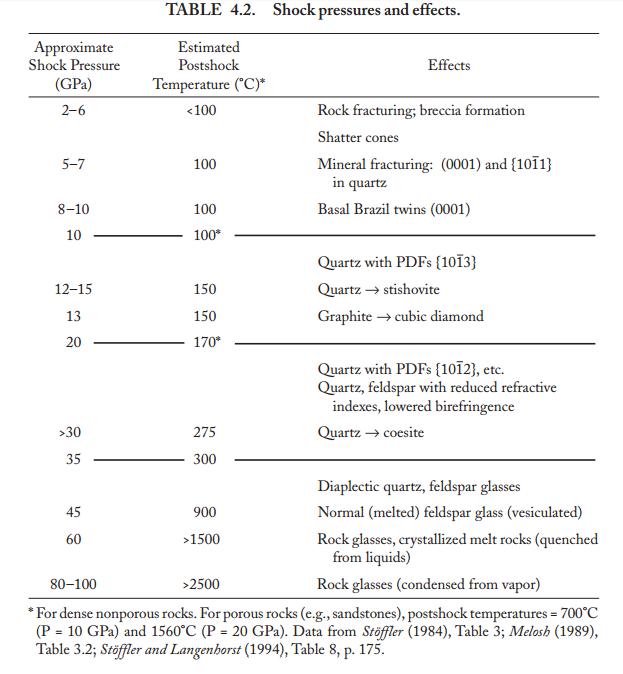
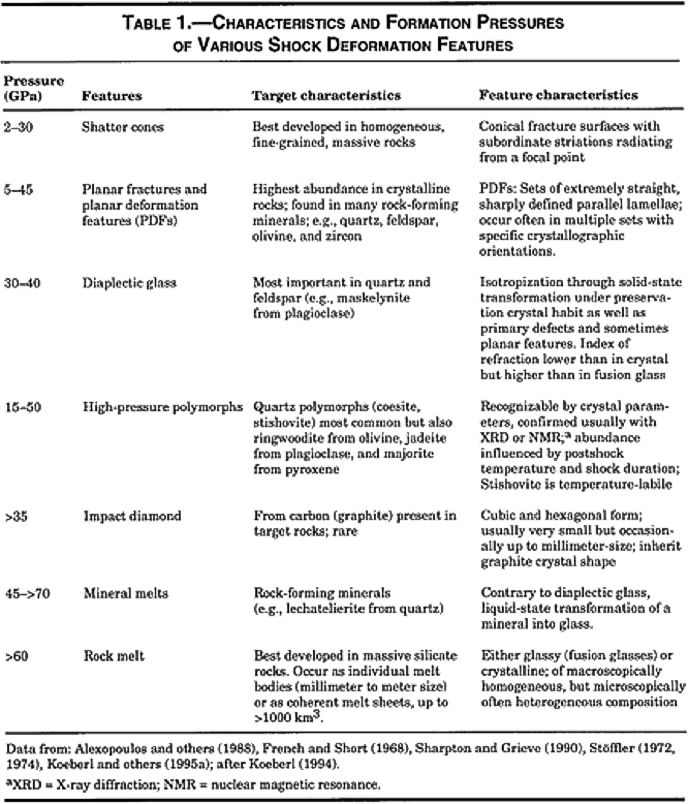
So yes, there are many varieties of Impact Shock Metamorphism Shock Stage Level diagrams available to use, and I have had all of these available.
The microscopic impact shock metamorphism effects are different for different target rock type materials and the microscopic effects are different for the same impact pressures and temperatures as a result. The high pressure and heat effects will be different for different target geologic rock types and their corresponding stratigraphy. The microscopic effects due to impact shock metamorphism will be different for target rock types such as soft sediment materials, or sedimentary rock types, or igneous intrusive or extrusive rock types such as intrusive Granites, or extrusive volcanic rock types such as Basalts, Dacite, Rhyolite, or Tuffs. In impact crater models used to determine original impactor size or resulting crater size, these models account for differences of target geologic rock types as a result. The microscopic effects due to the same impact shock pressure and temperatures, will have a different effect on different target rock types. This makes complete sense if one thinks about it.
Through more investigation I found this very important research article recently that illustrates these different effects for target igneous intrusive/extrusive siliceous volcanic rock types here on Earth ...
Shock Metamorphism of Siliceous Volcanic Rocks of the El’gygytgyn Impact Crater (Chukotka, Russia)
"The 18-km-diameter El’gygytgyn crater is located on the Chukotka peninsula, northeastern Russia. It represents the only currently known impact structure formed in siliceous volcanics, including tuffs. The impact melt rocks and target rocks provide an excellent opportunity to study shock metamorphism of volcanic rocks. The shock-induced changes observed in porphyritic volcanic rocks from El’gygytgyn can be applied to a general classification of shock metamorphism of siliceous volcanic rocks.
Strongly shocked volcanic rocks with phenocrysts converted to diaplectic quartz glass and partially melted feldspars as well as cryptocrystalline matrices are widespread in the El’gygytgyn crater. In particular, the following different stages of shock metamorphism are observed: (i) weakly to moderately shocked lavas and tuffs with phenocrysts and clasts of quartz and feldspars; (ii) moderately shocked volcanic rocks and tuffs with diaplectic glasses of quartz and feldspars; (iii) strongly shocked lavas and tuffs with phenocrysts of diaplectic quartz glass and fused glasses of feldspars in melted matrixes; and (iv) impact melt rocks and impact glasses. In addition, thin glassy coatings of voids in impact melt rocks have been observed.
While the shock-induced changes of clasts of framework silicates in these volcanic rocks do not differ from respective changes in other crystalline rocks, the finegrained matrix of porphyritic rocks is converted into fused glass at the same shock pressures as feldspar minerals. No remnants of fine-grained quartz are preserved in matrix converted into fused glass by shock.
Keywords: El’gygytgyn crater, shocked volcanic rocks, shocked
rhyolite, Chukotka."
That is exactly what I'm seeing in GSA Rhyolite, and GSB Dacite meteorites at the microscopic level. Now I have a very appropriate Shock Stage Level diagram or table to use with very specific descriptions of exactly what I have been seen at the microscopic grain level for GSA a Rhyolite meteorite from Mars, and GSB a Dacite meteorite from Mars, both falling in the same historic fall event, with specimens that have both lithologies igneously fused together, therefore from the same PB and fall event, all landing in the same footprint of the discovery/find site.
Perhaps this is why I get considerable traffic from Russia and the Ukraine to my website, (and also Moracco). I think the Russian meteoritcists, cosmochemists, and cosmologists know its very possible. They have the perfect outdoor analog lab and experiment with results to study in their own back yard. I'd like to visit this impact crater some day, the El’gygytgyn Impact Crater (Chukotka, Russia), approximately 18.0km (11.18miles) in diametrer. This impact crater is in the extreme NE region of Siberia near the town of Pevek, the historic mining region and unfortunately also historic Gulag country.
This is what happened on Mars, but with a larger impact event more than likely, and impact ejecting massive heterogeneous blocks of igneous extrusive volcanic rock into space (as meteoriods) to one day fall to Earth as meteorites. It can happen. It did happen. It happened here on Earth as with the El' gygytgyn Impact Crater and it happened on Mars in a more massive way, with Mars having a much lower escape velocity at (5.0 km/s), much less than Earth at (11.2 km/s). Planetary Fact Sheet - Metric.
Shock Metamorphism of Siliceous Volcanic Rocks of the El’gygytgyn Impact Crater (Chukotka, Russia)
The table they come up with for impact shock metamorphism effects of siliceous volcanic rocks of the El’gygytgyn Impact Crater (Chukotka, Russia)
follows ...
|
|
|
|
|
Microscopic impact shock metamorphism effects in igneous extrusive volcanic rock |
|
| Level 0 (0) |
|
|
|
| Level I (1) |
|
|
|
| Level II (2) |
|
|
GSA -- Rhyolite SSL 2 ? |
| Level III (3) |
|
|
GSB -- Dacite SSL 3 ? |
| Level IV (4) |
|
|
|
| Level V (5) |
|
|
Compare the Shock Stage/Level classifications of the 2 differrent tables that I used. The one before compared to this one above. The pressures more or less agree even though the SSL may not. They seem to agree somewhat in terms of impact shock pressure, however, each table denotes a different number for the shock stage. So for comparison purposes it is best just to look at the impact shock pressures achieved. When you do, the impact shock pressures that I first determined for GSA and GSB are somewhat the same as before.
Original SSL table used:
GSA = SSL 4, 30 - 35 Gpa
GSB = SSL 5, 45 - 55 Gpa
El’gygytgyn Impact Crater study SSL table:
GSA = SSL II (2), 35 - 45 Gpa
GSB = SSL III (3), 55 - 60 Gpa
> Your samples don't appear to show any
evidence of undulatory extinction in
> olivine, as would be needed to place your rocks on this
> diagram<http://www.gfoundit-mars.com/ImpactShockMetTables2.jpg>.
You are correct. No olivine in the analyzed samples of GSA and GSB, or very few grains and very isolated. GSA is an igneous extrusive Felsic volcanic rock -- Rhyolite. GSB is an igneous extrusive Intermediate-Felsic volcanic rock -- Dacite. Both are evolved lavas. Olivine is not a primary mineral within Dacite or Rhyolite. See the many igneous rock classification tables and graphics below (5). I'm sure you know this as a geologist.
You are incorrect. Olivine is not needed to place meteorites or impact shocked country rock (target material) on the Shock Stage Level table used. Quartz and Plagioclase Feldspar are also used as mineral grains to determine impact shock metamorphism and SSL. It does not have to be Olivine. As I said, it is one of several minerals that can be used. The table indicates this as well.
Olivine as well as other minerals do behave differently due to the same impact shock pressures and temperatures (the SSL table indicates this) from the same impactor depending on the host rock type that the impactor slams into (target material), i.e. soft sediments, sedimentary rock, igneous intrusive rock, or intrusive/extrusive volcanic rocks as a few examples. In other words, olivine may not show impact shock effects in say an extrusive volcanic rock target rock type as it would in sedimentary target rocks given the same impact shock pressures and temperature from the same impactor. The El’gygytgyn Impact Crater (Chukotka, Russia) Study bears this truth out in comparison to other target rock types.

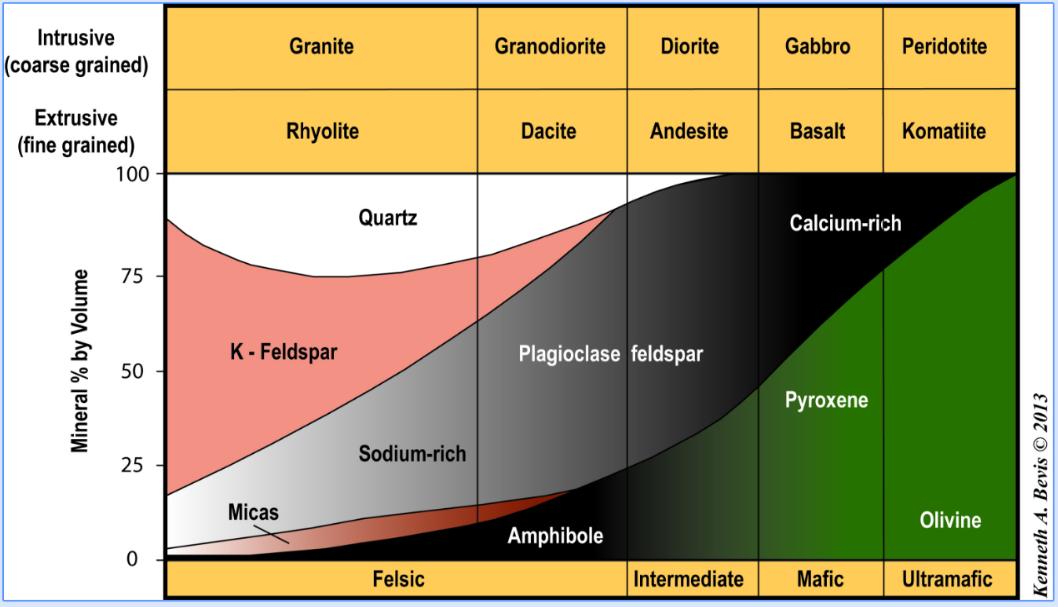
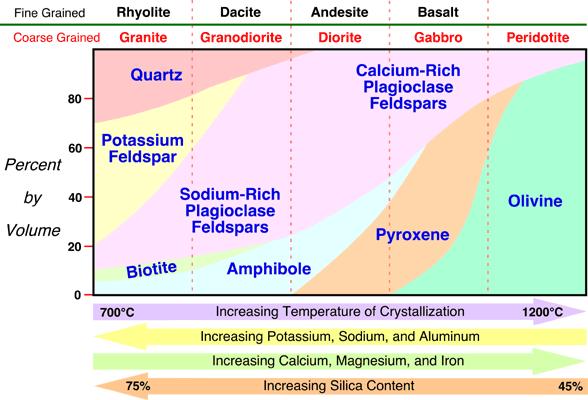
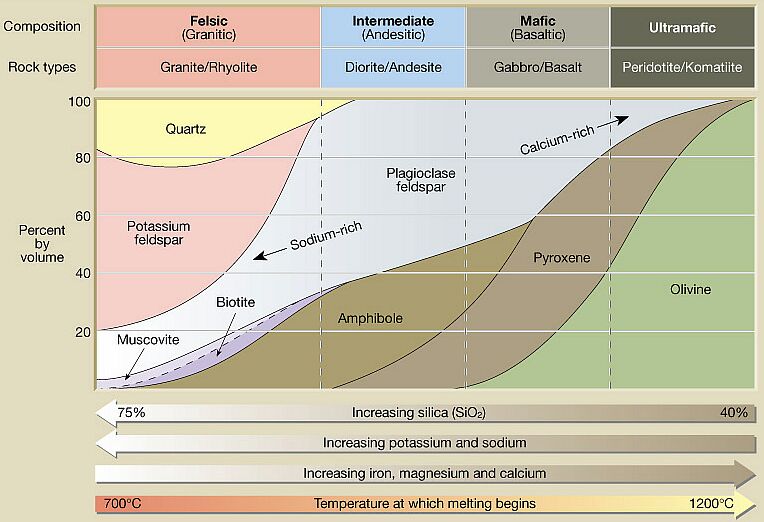
The fact
> that you have ignored the text stating that the observed
undulatory
> extinction must be in olivine is telling; whoever called
your rock "S3" had
> no idea what they were doing.
I haven't ignored it. And other mineral grains such as quartz and plagiclase feldspar can be used.
You are incorrect to suggest that the undulatory extinction MUST BE in olivine. That is laughable. There are many other minerals to use. Olivine is just one of many. Even the impact shock diagram I originally used indicates undulatory extinction in other mineral grains. You are not honestly interpreting this SSL table. There are many other impact shock stage diagrams to utilize, this is just one of many.
Another ad hominem attack. A few mistakes made but the overall conclusion is the same. They are Meteorites and the PB is Mars.
Since you are making so many mistakes and misrepresenting the data so erroneously, and making ad hominem attacks, perhaps you have another agenda that isn't science?
See the above SSL tables.
Olivine and quartz don't show similar shock
> features at similar pressures. They are different minerals
with different
> basic physical properties.
>
You are stating the obvious. Even the untrained public looking at these SSL tables would realize this fact as the table bears it out.
This is very obvious due to the fact in all tables that describe impact shock metamorphism effects at the mineral grain level, they always separate the effects on Quartz, Plagioclase Feldspar, and Olivine at the same pressures and temperatures due to impact. These minerals behave differently at the same pressures and temperatures. Again, you are stating the obvious. Please cue the "Captain Obvious" commercial ...
> The "planar deformation features" you have noted
in quartz appear to be
> indigenous crystallographic features that do not completely
transect any
> grains. This<http://minerals.cr.usgs.gov/gips/images/colormed.gif>
is what
> shocked quartz looks like.
You are incorrect. PDFs do not have to transect the entire mineral grain, and often times do not. Many sources that discuss and describe impact shock metamorphism effects discuss this fact and show this in micrographs when discussing PDFs. There are very fresh in appearance and very distinct PDFs, and there are PDFs that are not distinct and weathered or "ghost like," or having become somewhat erased to a large affect by higher impact shock level effects or weathering. Many of these PDFs will not cross the entire grain as a result. Classic academic "tunnel vision" on your part.
Note the vibrant mosaicism due to physical
strain
> stored within the grain. This is conceptually similar to
the optical
> distortion you can observe in Prince Rupert's
> Drops<https://en.wikipedia.org/wiki/Prince_Rupert%27s_Drop>
in polarized
> light. The linked image of shocked quartz also shows abundant
obvious
> parallel lines as a result of shock (also, see
> here<http://www.sail2ak.com/ray/classes/sem/final_project.html>).
There are
> no such features in anything on your website.
You are incorrect. Mosaicism does not have to be vibrant. Impact shock metamorphism effects within Quartz and Plagioclase Feldspar grains can show mosaicism from weak to strong due to impact shock effects, it is not an all or nothing effect. It's a gradiant. Again you are suffering from academic tunnel vision looking for only vibrant textbook examples of mosaicism, and missing the obvious clues all around. There are plenty of mosaicism examples within the quartz grains throughout GSA and GSB.

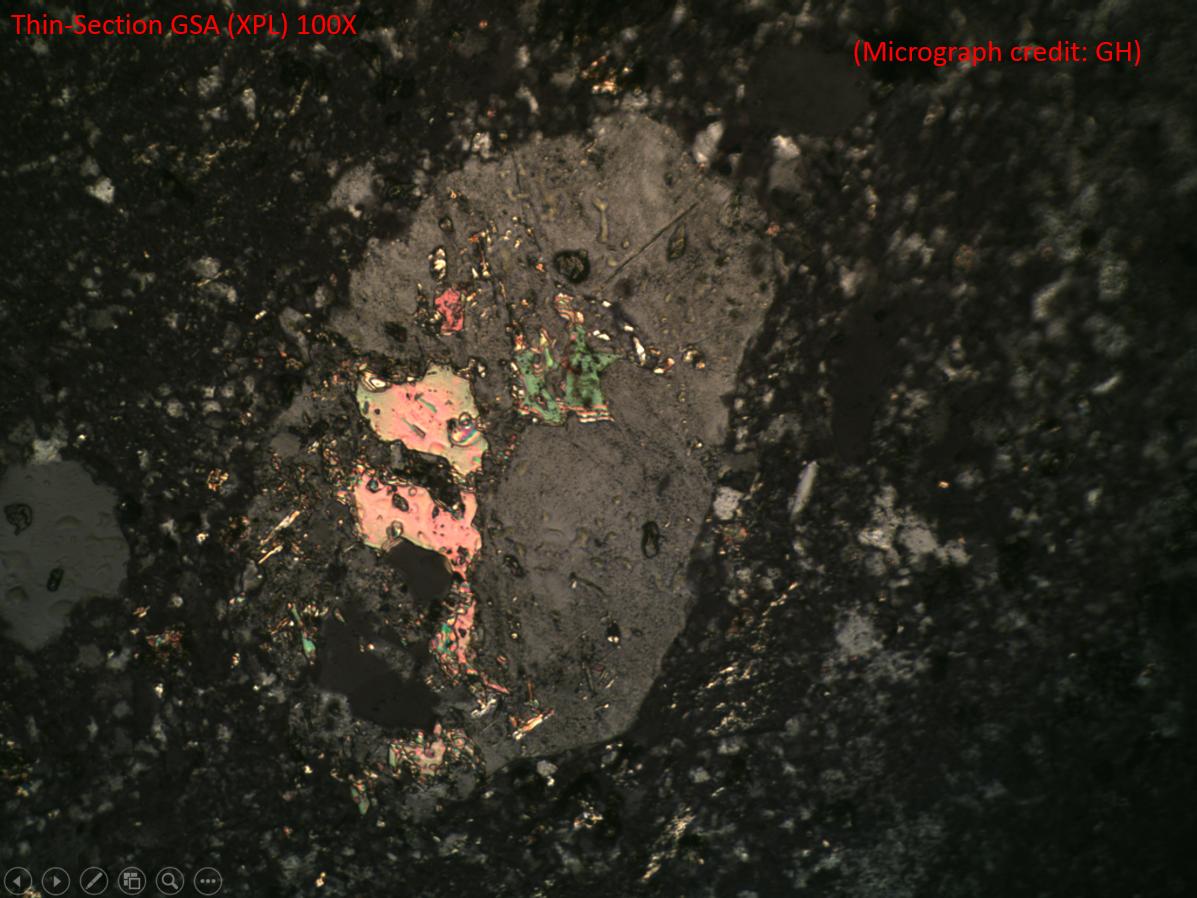


Add resource links on mosaicism ...
> This<http://www.gfoundit-mars.com/GSAXPL40XEnlPDFs2.jpg>
(and
> this<http://www.gfoundit-mars.com/GSB2XPL100XPlanFracPFs1.jpg>)
is not
> shocked quartz, and the "undulose extinction" you
show on your website is
> typical terrestrial metamorphism. We can refer back to the
> video<https://www.youtube.com/watch?v=HpTENXNj8es>
I linked to above, showing
> XPL undulatory extinction of quartz in granite.
It can be due to terrrestrial metamorphism strains, but not so when the grain is surrounded by all the other effects of impact shock metamorphism and also all the other effects within the same grain.
You are wrong and you are repeating yourself. I already dealt with this completely up above in your email. Please see above.
Also note the faint
> crystallographically oriented lines partially crossing several
of the grains
> in the video. That's not shocked quartz. Those are regular
crystal features
> that you would find in nearly every quartz grain on Earth.
>
Yes, noted.
> This<http://www.gfoundit-mars.com/ThinSectGSB2EviArt6.jpg>
isn't amphibole.
> It's calcite<http://www.geo.arizona.edu/geo3xx/geo306_mdbarton/classonly/306%20Web%20Materials/306_Lecture041122_files/image084.gif>.
> Which reflects metamorphism or hydrothermal alteration. Again,
a common
> feature you would see in an ordinary terrestrial rock.
>
You are correct. The mineral grain is micro-twinning Calcite (CaCO3). I shouldn't have made this mistake since EMPA identified Gypsum near this grain which also exhibits micro-twinning due to impact shock metamorphism.
It does indeed demonstrate metamorphism, but due to impact shock metamorphism, and impact melting. This Calcite mineral grain is demonstrating classic and many impact induced parallel mutliple sets of micro-twinning within the Calcite grain. This is not a common feature in ordinary terrestrial rock, since this micro-twinning occurs due to impact shock metamorphism.
See these research articles on this impact shock effect within Calcite:
CONSTRAINING THE PRESSURE THRESHOLD OF IMPACT INDUCED CALCITE TWINNING
See micro-twinning in Calcite:
http://www.impact-structures.com/shock-metamorphism-page/
"In calcite, shock may lead to intense micro-twinning otherwise rarely observed in tectonically deformed calcite."
And this study ...
Impact metamorphism of CaCO3-bearing sandstones at the Haughton structure, Canada
"Early workers recognized the common occurrence of shatter cones in limestone (Robertson and Mason1975) and the intense twinning of calcite (Robertson and Grieve 1978) at the Haughton impact structure, which they ascribed to the impact event. Subsequently, lattice defects (fractures and planar defects) that “could be interpreted as direct shock effects” were recognized in carbonates, also at Haughton (Martinez et al. 1994a). Shock experiments and thermodynamic calculations can provide important information regarding shock processes; ..."
Not only do these micrographs below show many very definitive and intense micro-twinning in Calcite due to impact shock metamorphism, but you also fail to acknowledge the micro impact melt FeOs globules that have been injected into the matrix of this Mars meteorite from the original impactor "the smoking micro-bullets," and directly coming to rest within this Calcite mineral grain from left to right in the following micrographs, and you can see the glass strain and impact melt very well in the XPL. Why do you ignore the extraordinary and overwhelming evidences? Once again I ask you, do you have another agenda that isn't science?



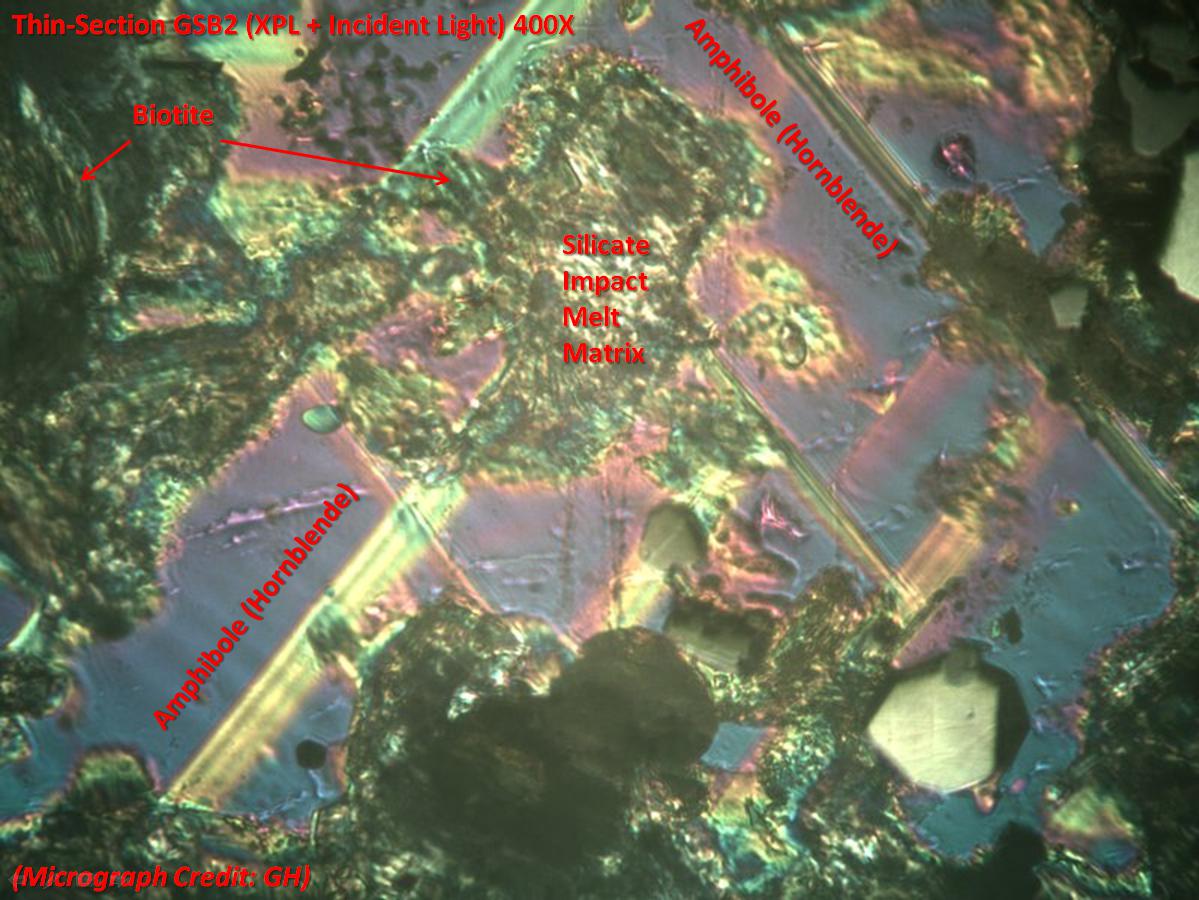

> Your depictions of "toasting" and "decorative
PDFs" are likewise misconstrued.
> This image<http://www.gfoundit-mars.com/GSAXPL100XDecorPDFs2.jpg>
most likely
> shows a dusty plagioclase grain with twinning that you mistakenly
label as a
> "PDF in quartz." Note the complete lack of linear
features throughout the
> grain -- except for the one lighter band you mark
> here<http://www.gfoundit-mars.com/GSAXPL100XDecorPDFs1.jpg>.
That band is
> far too wide to be a typical PDF, and is instead a normal
twinning plane,
> probably in plagioclase (not quartz). Since the two exhibit
similar levels
> of birefringence, they are often mixed up by petrology students.
>
For "toasting" see the next response.
> There is no "toasting" in this
> image<http://www.gfoundit-mars.com/GSAXPL40XShMeltToast1.jpg>.
Those are
> normal dirty, fractured mineral grains that you would find
in ~any
> metamorphic rock, most sedimentary rocks, and many igneous
rocks.
Please see these research articles below on "toasting" in quartz due to impact shock metamorphism. "Toasting" occurs in quartz, through quartz, and across quartz grains due to impact shock metamorphism. It is both brown in PPL and XPL. This is true for the images I posted of GSA.
"Quartz present in the target rocks at impact sites and as clasts within impact melt rocks and some psuedotachylytes commonly exibits a brown, nonpleochroic grainy appearance in plane- and cross-polarized light, known as 'toasted' quartz."
This is exactly exhibited in GSA to a very large extent with the micrograph images that I present as evidence. It is due to impact shock metamorphism only and it is rare.
There is nothing "normal" or "dirty" about it. Nor would you find this effect in any common metamorphic rock, sedimentary rock, or igneous rocks, unless the rocks experienced impact shock metamorphism. Nothing normal or common about impact shock metaporphism and "toasting." It's rare due to impact shock metamorphism.
Origin of “toasted” quartz in terrestrial impact structures
and
THE ORIGIN OF “TOASTED” QUARTZ IN IMPACTITES REVISITED
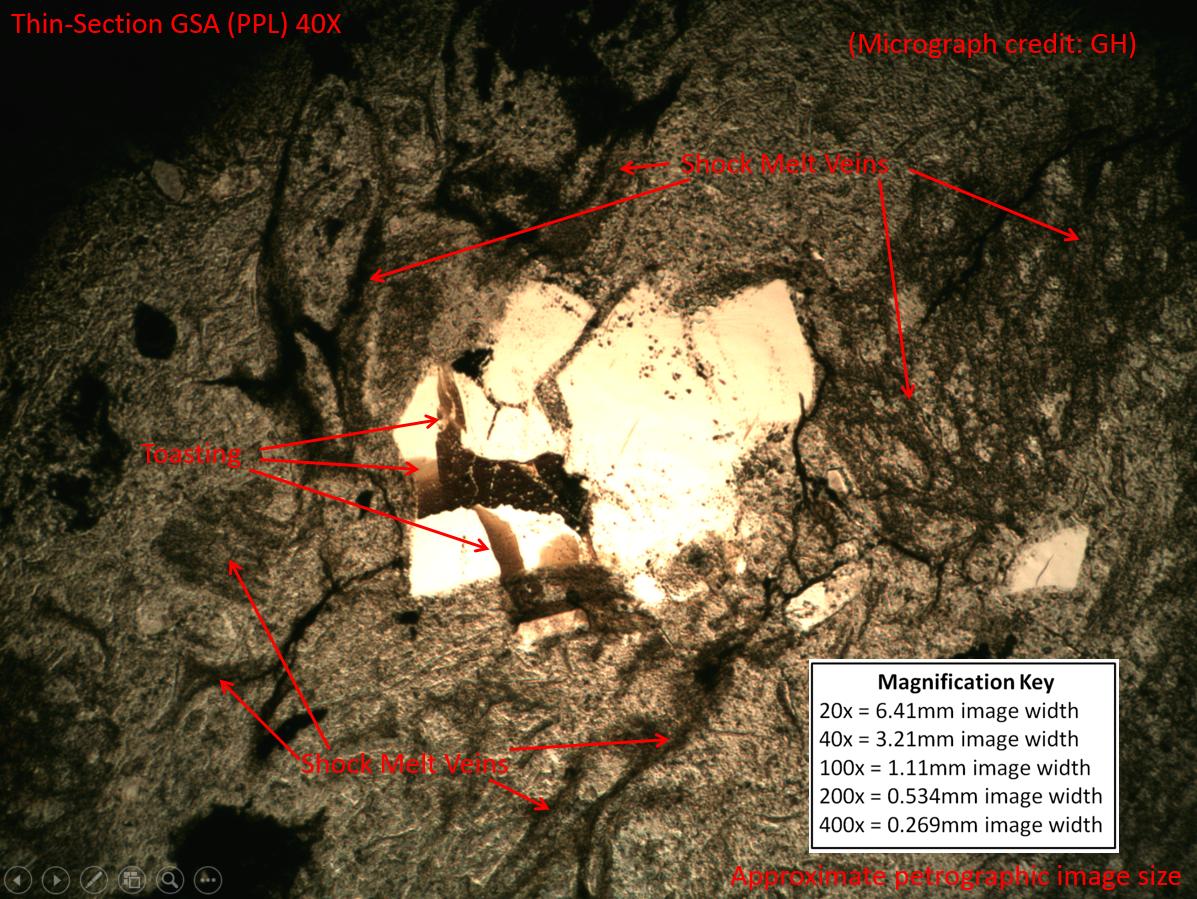

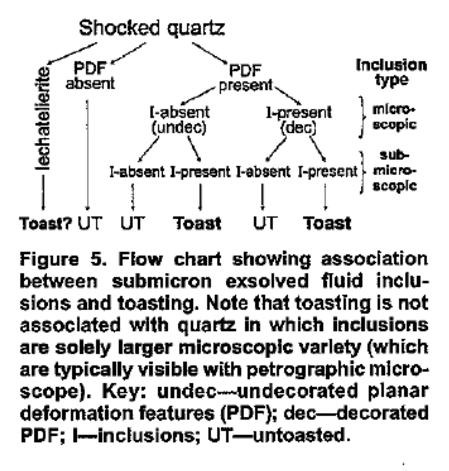
The "shock
> melt veins" pictured contain abundant light and green
mineral grains, so they
> cannot be quenched shock-melt or glass, which would be isotropic
(uniformly
> black in XPL). They appear to be minerals deposited along
simple fractures
> during metamorphism, like epidote, etc. Very common in terrestrial
rocks.
>
You are thinking with textbook like examples of the phenomenon only, and serious academic tunnel vision. Once again, uniform impact shock pressures and temperatures do not go through the target material or meteorites from impact shock evenly or equally. See the study I discussed and posted before ...
This research paper within the first paragraphs describes these effects very well ...
Shock Effects in Meteorites, by Thomas G. Sharp and Paul S. DeCarli
http://www.lpi.usra.edu/books/MESSII/9040.pdf
Many meteorites that have been impact shocked to higher levels that exhibit diapletic glass and show isotropic extinction in XPL in the background matrix of the rock (or meteorite), or impact shock melt veins are not always complete. They can be but they often aren't completely shocked or melts. There are lingering small or cryptocrystalline minerals throughout the diapletic glass that remain. It isn't an all or nothing phenomenon. There are different grades of diapletic glass. It can vary from little diapletic glass with many birefringent original mineral crystals scattered throughout the matrix in XPL, to complete diapletic glass and complete isotropic black in XPL. It is a wide varing range. As I've said it isn't an all or nothing phenomenon.
May I suggest that you get a copy of "A Color Atlas of Meteorites in Thin Section," by Dante S. Lauretta and Marvin Killgore and study all the color plates of Stony Meteorites: Chondrites and Achondrites and you will know the truth of this matter.
You are incorrect.
A Color Atlas of Meteorites in Thin Section, by Dante S. Lauretta and Marvin Killgore
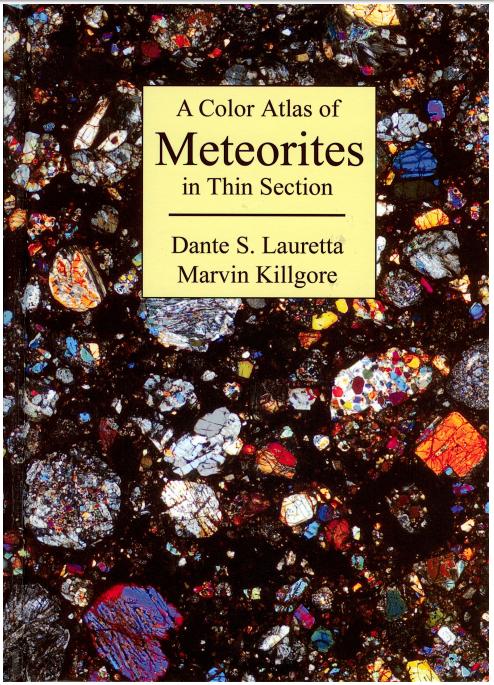
> You place your rocks on a diagram of igneous Martian rocks,
but they would
> fit just as well on a normal terrestrial diagram:
> here<https://upload.wikimedia.org/wikipedia/commons/c/c0/Petrology_Igneous.jpg>.
Yes, I could, but that would be foolish to do so since my discovery on a megascopic level is a meteorite find and discovery. On a macroscopic level they are meteorites. On the microscopic level they are meteorites exhibiting impact shock metamorphism at the mineral grain level throughout the rock matrix of the specimens, and at the geochemistry/cosmochemistry level they validate as being from Mars, so therefore the Parent Body is Mars. So placing them on a terrestrial (Earth) TAS classification diagram would be incorrect and foolish.
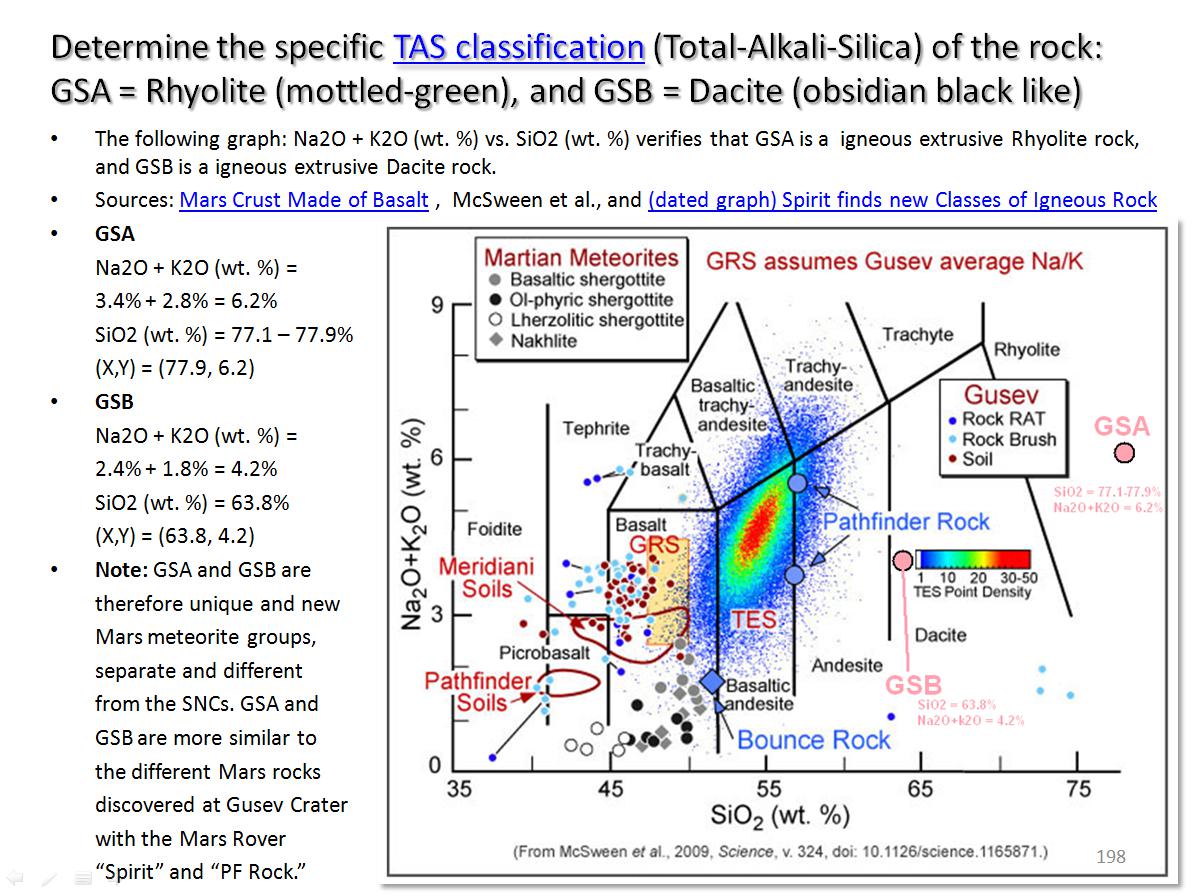
> You also mention that you used the "Michel-Levy Method"
to determine your
> rock's bulk FeO/MnO ratios. The Michel-Levy Method is used
to determine
> (very roughly) the composition of plagioclase, based on its
optical
> extinction. Nothing else. In other words, that claim / statement
is
> nonsense.
>
You have interpreted the graph incorrectly and therefore you are wrong. You are suggesting things that I didn't say or do.
Interpreting graphs and the titles to graphs, basic 101 stuff ...

The title of a graph is properly titled as Y vs. X. The Y-axis data comes first, vs., and then the X-axis data, in a properly formatted title. In this case we have on the Y-axis: Whole Rock Bulk FeO/MnO ratio, vs., and on the X-axis : Plagioclase, %Anorthite (Michel-Levy Method) within GSA and GSB for Perent Body Determination.
The data for the Y-axis: Whole Rock Bulk FeO/MnO ratio, came from ICP-MS whole rock and trace mineral analysis. This bulk FeO/MnO data did not come from the Michel-Levy Method which is an optical mineralogy technique using grains of Plagioclase, to only determine % Anorthite. Nor did the graph ever suggest that it did. You misread the graph which is properly titled and labeled. Along the margin of the Y-axis it indicates:
--Diagnostic Mars bulk FeO/MnO or Fe/Mn = 35 - 50
--Diagnostic Earth bulk FeO/MnO or Fe/Mn = 50 -70
GSA
Bulk FeO/MnO = 42.45
Bulk Fe/Mn = 42.60
This falls within the diagnostic Mars bulk FeO/MnO ratios, therefore it indicates the Parent Body is Mars.
GSB
Bulk FeO/MnO = 119.31
Bulk Fe/Mn = 119.75
GSB FeO/MnO is high due to large amounts of FeO from original Asteroid impactor.
The data for the X-axis: As noted, comes from the optical mineralogy technique called the Michel-Levy Method, an optical way to determine % Anorthite within grains of Plagioclase. The more grains of albite twin lamellae checked using this optical technique the better the accuracy of the test. I checked 18 grains within GSA, and 22 grains within GSB. The text, Introduction to Optical Mineralogy, by PhD William D. Nesse (2004), explains the process very well (pg.138 - 140).
I was compelled by a very helpful PhD electron micro-probe technician (who will remain anonymous at this time) to learn and use this technique. We were running out of time on the electron-micro probe studying GSA and GSB thin-sections and looking at particular grains of interest and the Ni enriched micro-lamaellae within grains of FeOs. He said, "Glyn just learn and use the Michel-Levy Method, to measure % anorthite to determine the parent body according to the Papike research article you brought in and shared with me. When you return for more electron-micro probe work with me, you'll already know the parent body." By the time I returned to work with this PhD analyst on the electron micro-probe, I knew the Parent Body for GSA and GSB was Mars, therefore my entire discovery was indeed from Mars.
You do not have to use an electron micro-probe to measure % Anorthite (as Papike suggests) within grains of plagioclase to determine the Parent Body of meteorites originating from differentiated terrestrial planetary volcanic rock from known planetary bodies (Mercury?, Earth, Moon, Mars, and Asteroid 4 Vesta at this time). It's faster and perhaps less involved using the electron-micro probe, but with time and patience and testing many grains, the Michel-Levy Method works very well and can be used to determine % Anorthite accurately. The results ...
Original resource/graphics from the research article:
American Mineralogist: Determination of planetary basalt parentage: A simple technique using the electron microprobe, J.J. Papike, J.M., Karner, and C.K. Shearer
GSA
Plagioclase, % Anorthite = 46%
This is well within the % Anorthite that indicates Mars is the Parent Body alone.
GSB
Plagioclase, % Anorthite = 44%
This is well within the % Anorthite that indicates Mars is the Parent Body alone.
In summary, the evidence is empirical, the Parent Body for the meteorites GSA and GSB is Mars.
I'm surprised you didn't argue the other empirical tests derived from the whole rock oxide and trace mineral analysis data determined by ICP-MS, such as Mg/Si (wt. ratio) vs. Al/Si (wt. ratio) that validates that the Parent Body is Mars yet again, as well as these many other tests ...

GSA:
Six additional tests that validate the parent body for GSA as Mars has been done: ppm K vs. ppm La graph, K/La vs. La (ppm) graph, MnO (wt.%) vs. FeO (wt.%) graph, K2O (wt.%) vs. La (ppm) graph, Cr (ppm) vs. Mg # graph; GSA/vfcl, GSB/vfcl, vfcl vs. REE (g/t) proves GSA and GSB match the same PB.
GSB:
Five additional tests that validate the parent body for GSB as Mars has been done: ppm K vs. ppm La graph, K2O (wt.%) vs. La (ppm) graph, Cr (ppm) vs. Mg # graph, and MnO (wt.%) vs. FeO (wt.%) graph (last graph indicates not from Earth, but inconclusive for Mars); GSA/vfcl, GSB/vfcl, vfcl vs. REE (g/t) proves GSA and GSB match the same PB.
> Your macroscopic evidence is no better.
> That<http://www.gfoundit-mars.com/GSBEviArt1.jpg>
looks nothing like fusion
> crust. That rock is a typical water-worn pebble with some
desert varnish.
> Take it from a geologist with almost two decades 'in meteorites.'
>
Try viewing it in 3D and zooming in. There is a reason I provided many large images in stereograms. Depth of perception helps tremendously. I'm surprised others aren't posting their images of meteorites in 3D stereograms. Perhaps I'll start a trend.
PhD Randy L.Korotev has a wonderful website that I've used for many years. He has a good page on meteor-wrongs. But there is also the danger of only looking for classic examples and missing the extraordinary example. Classic tunnel vision. "Bikkurim" and GSB both have a classic fusion crust due to its high content of magnesium (Mg) even though it is high in silica also. It has weathered some. But many of the features are seen that I call out in "Bikkurim." Classic regmaglypts due to "Bikkurim's" high content of FeOs, as well as the macro-effects I call out in GSB. A magnet jumps to Bikkurim very vigorously. A magnet jumps to GSB as well, but less so. GSB is loaded with shiny FeOs grains, many indigenous in-situ to Mars igneous volcanic rock, and some from the original impactor. Interesting you purposefully steer clear of discussing the abundant FeOs and Sulfides both in GSA and GSB, both of which often occur in Mars meteorites that have been discovered, and it is noted that FeOs and Sulfides are often ubiqutious within the matrix of Mars meteorites. Like I said, zoom in and view in 3D stereo. I'll have to do closer images with the remaining masses of GSA and GSB. At some time I will get to that.
GSA is very high in silica without the magnesium (Mg). What would be the fusion crust of quartz falling to Earth? I know what it would be. It's going to be a very thin clear shiny varnish of quartz melt, like someone just sprayed it with shiny clear lacquer. Only now it is a clear, glossy and a thin veneer of Lechatelierite.
http://meteorites.wustl.edu/lunar/moon_meteorites.htm
All I can tell you is it was found somewhere in the USA.
Wow, so I should just take your word for it? That's laughable.
I guess the aerodynamic pyramidal shape (which by the way is a very stable fall shape through an atmosphere) of the famous "Black Beauty" and my GSB: "The Real Black Beauty" aren't similar at all right? I'm being sarcastic. There is a reason I called it "The Real Black Beauty." Similar shape, yet it truly is very black. Solid black Dacite. It was found many years before "Black Beauty." It has fusion crust, and all the features can be seen. I will post more up close images so these features can be seen in 3D when I get to it.
Add in more macroscopic and microscopic evidences for GSA and GSB:
*Stereo-pair images of fusion crust, melt accumulate, drip-lines, regmaglypts etc. of both GSA and GSB. Very significant.
*The Mohs hardness of GSA and GSB indicating impact shock metamorphism due to impact shock pressures and temperatures, and impact shock recrystallization hardening the over-all rock matrix greater than Mohs 7.0+. Very significant.
*Full-view images of thin-sections GSA and GSB in Reflected Light, PPL, and XPL. FeOs and a few other opaque reflected light minerals are ubiquitous in many Mars meteorites. The same is true for GSA and GSB. See next bullet point ...
*Talk about and image compare GSA and GSB to other Martian meteorites that show FeOs and Sulfides in reflected light throughout the matrix of the thin-sections, just like GSA and GSB do, from Lauretta's and Killgore's book. Quote what this means.Very significant. Also add images from the book.
*GSB at the microscopic level shows impact melt globules with "smoking micro-bullets" in-bedded into the shock metamorphosed crystal of micro-twinning Calcite from the original impacting event on Mars. It even shows the injecting direction within the thin-section of the rock matrix, and the terminating point of the impact melt globule into the target material of Dacite (the ultimate stopping point near the grain of Calcite).Very very significant. I would imagine very rare to see.
*New phenomenon not seen before or described before until now (more than likely due to impact shock metamorphism effects), Ni enriched micro-exsolution lamellae within grains of FeO's.
*Additional geochemistry graph: FeO*/MgO (wt. ratio) vs. silica diagram (wt. %) used for distinguishing dry thoreiitic (TH) from wet calc-alkaline (CA) rocks. http://www.psrd.hawaii.edu/May09/Mars.Basaltic.Crust.html
Also see this related PPT: PSRD -- Mars Basaltic Crust
> I don't know where to begin on this
> image<http://www.gfoundit-mars.com/BikkurimEviArt3.jpg>.
It looks like a
> normal terrestrial rock that has been weathered in a desert
environment for
> an extended period of time. Nothing described in the caption
is visible in
> the photo.
I repeat ....
Try viewing it in 3D and zoom in. There is a reason I provided many images in stereograms. Depth of field for perception helps tremendously. I'm surprised others aren't posting their images of their meteorites in 3D stereograms. Maybe I'll start a trend.

PhD Randy L.Korotev has a wonderful website that I've used for many years. He has a good page on meteor-wrongs. But there is also the danger of only looking for classic examples and missing the extraordinary example. Classic tunnel vision. "Bikkurim" and GSB both have a classic fusion crusts due to their high content of FeOs and magnetite even though each is high in silica also. It has weathered some. But many of the features are seen that I call out in "Bikkurim." Classic regmaglypts due to "Bikkurim's" high content of FeOs. A magnet jumps to it very vigorously. A magnet jumps to GSB as well, but less so. GSB is loaded with shiny FeOs and sulfide grains, look at the reflected light images of the thin-sections. Like I said, zoom in and view in 3D stereo. I'll have to do closer images with the remaining masses of GSA and GSB.
Add images of reflected light FeOs in GSB (and eventually in GSA) in thin-section here ...


There are abundant FeOs and Sulfides grains and more throughout the matrix of both GSA and GSB, which often occur in Mars meteorites that have been discovered, and it is stated that FeOs, Sulfides and other opaque reflective minerals are often ubiquitous to the matrix of Mars meteorites. See PhD Dante Lauretta and Marvin Killgore's text and the section on Mars meteorites.
A Color Atlas of Meteorites in Thin Section, by Dante S. Lauretta and Marvin Killgore
GSA is very high in silica without the high amounts of FeOs and magnetite, but it does have them throughout the matrix. Q: What would the fusion crust of quartz falling to Earth be like? I know what it would be. It is going to be a very thin clear shiny varnish of quartz melt, like someone just sprayed it with shiny clear lacquer. Only now it is a clear, glossy and a thin veneer of Lechatelierite.
Add Websites on Fusion Crust
http://meteorites.wustl.edu/lunar/moon_meteorites.htm
You sure do assume a great deal. All I can tell you is it was found/discovered somewhere in the USA.
I guess the aerodynamic pyramidal shape of the famous "Black Beauty" and my GSB: "The Real Black Beauty" aren't similar at all right? (I'm being sarcastic.) There is a reason I called it "The Real Black Beauty." Similar aerodynamic pyramidal shape, yet it truly is very black. Solid black Dacite. Also it was found/discovered many years prior to the discovery of "Black Beauty."



(This U.S. WR Mars Meteorite Discovery significantly predates the new NWA 7034 "Black Beauty" Mars meteorite recently discovered. Here is a very interesting presentation on NWA 7034 "Black Beauty" by PhD. Carl Agee, UNM. Here's another shorter concise presentation on NWA 7034.)
The caption also seems to suggest that even
relatively small
> meteorites experience "shock" when they reach the
Earth's surface. This is
> one of several common misconceptions that people have regarding
what
> transpires when meteorites hit the ground.
>
My image and caption does not seem to suggest or indicative the meteorite experienced shock from hitting the Earth's surface. I never said that. It is simply a list of things to commonly look for and observe that can tip the meteorite hunter that they have found something of significance and to investigate further. My descriptive caption is relating to the original impactor into Mars that can and does produce small impact shock fractures within the meteoritic material that gets ejected from the surface of a Parent Body into space at escape velocities. This is an effect from the original impactor into the original Parent Body target material. I'm fully aware that many meteorites actually fall to Earth, after braking through the Earth's atmosphere, to merely fall to the ground with no catastrophic event ensuing, although you wouldn't want to be hit by it falling even at those relative speeds. It would be deadly.
> I did not observe any evidence on your website that appeared
to accurately
> suggest that your rocks were meteorites, shocked in any way,
or from any body
> other than Earth.
>
> ----------
>
"You can lead a horse to water but you can't make them drink."
I think something else is at play: unprofessional jealousy, envy, and anger. Not right to act that way. You're a PhD candidate in Cosmochemistry. May I suggest that you don't exhibit these personal characteristics when defending your thesis or perhaps later when you are working with colleagues and/or students.
> As Carl Sagan said, "Extraordinary claims require extraordinary
evidence."
> You have made extraordinary claims, but the evidence you
have put forth does
> not corroborate them. Instead, it suggests that your rocks
are typical
> ~igneous rocks from Earth.
>
The evidences are in fact very complete. You have just chosen to ignore them. You are not being observant. That is not good science. Not professionally ethical on your part either. May I suggest taking a course on ethics in science?
> I can't stress this enough. The evidence you have put forth
literally
> refutes the idea that your specimens are either shocked,
or meteorites. The
> photos and thin section images suggest that you have found
an area with
> ordinary, unshocked, generally silicic volcanic rocks. These
rocks make up a
> substantial portion of Earth's surface.
Again, not true. You're just throwing out unsubstantiated attacks, as though just saying it makes it true. That's not how science works. All the evidence is there in logical order, empirical, and in great amounts. The shock evidence is there in grand amounts.
Again, more ad hominem like attacks without substance just misinformation/disinformation.
A few mistakes were made but easily corrected, and I have. Thank you for bringing it to my attention. And then once again it gives the empirical evidence that GSA and GSB are indeed meteorites from Mars. The overall conclusion is the same. They are meteorites and they are from Mars.
There is not one shred of evidence
> in everything you have written and/or posted that suggests
that your rocks
> are shocked, or not from Earth. Or that they might be from
Mars. On the
> contrary, the evidence suggests that you do not understand
how to identify
> even common minerals in a polarizing microscope, and that
you are not
> familiar with diagnostic shock features in minerals. Any
geologist would say
> as much. Perhaps with more tact.
>
You keep repeating your same wrong observations and erroneous conclusions, and ad hominem like attacks, supposing that just saying it over and over again makes it true.
Mistakes can happen. It wasn't invalidating the final conclusion. Once corrected, the conclusion is the same: megascopic field evidence = meteorites, macroscopic evidence = meteorites, microscopic evidence of impact shock metamorphism effects throughout = meteorites, all the geochemistry evidence = the parent body is Mars. All add up to the empirical facts that they are meteorites and the Parent Body of origin is Mars. They are simply and factually ... meteorites from Mars.
> John Cleese has a viral video circulating that makes an astute
observation:
> for a person to understand what they do not know, they first
need to begin to
> understand what they do know. The fact that you would attempt
to identify
> minerals and rare mineral features without first working
to obtain a basic
> understanding of birefringence, or how to discriminate between
common
> minerals or mineral features in a microscope, speaks to this.
More ad hominem attacks. A few small mistakes were made. They were corrected. The conclusion is the same. They are meteorites from Mars.
Your website
> describes things that many people with college-level geology
degrees never
> even see in labs.
You are correct. Try to hold back the jealousy, envy, and anger. My discovery is extraordinary and World Record setting in many many different ways. This is true. It is a very unique and a very significant discovery, therefore no one else would have seen it before. A great amount of new pure science is coming out of this, and is going to come out of all of this incredible Mars meteorite find regarding this U.S. World Record Mars Meteorite Discovery (U.S. WRMMD). As noted much already has. I have not even disclosed all of the discovery yet. Much more to come in time ...
It breaks many records and achieves many new superlatives in the study of meteoritics. This is all true. Many research papers down the road will be written concerning this entire discovery. Look at all the research the Mars meteorite ALH84001 has generated, and that was just one special Mars meteorite. I'm certain many PhDs will add tremendously to their publication counts, and I'm sure many Master and PhD theses will result from this discovery too. I can think of one person in particular who is well on his way ...
See: A List of Superlatives for the U.S. World Record Mars Meteorite Discovery (USWRMMD)
The problem is that you have never seen them,
either. You
> do not have a good frame of reference.
So said Hooke to Newton ...
Again that absolutely wrong statement strikes me as filled with jealousy, envy, and anger.
Well you are wrong. I've been teaching Earth Science, and Space Science/Astronomy is a big part of the curriculum. I teach "From Space to your face" approach and this pedagogy is the best way by far for teaching this incredible field of study. I've been studying Meteoritics for nearly 15 years. My collection of samples from well known and even famous meteorites is growing and my personal library is always growing in addition. I was very fortunate to have a very good friend and colleague who got me started nearly 15 years ago in meteoritics and loaned me his copy of H.H. Ninniger's, "To Catch a Falling Star," the Father of modern meteoritics and whom was also self-taught. I now of course have my own copy.
I know how to do science. I teach it. I've done the scientific method in my approach and study. A few mistakes were made, not a big deal. Now rectified. The conclusion is the same. My theory is validated with all the evidences. They are meteorites and they are from the Parent Body Mars. Yes, not the typical approach to publication, but it works in our day and internet age. I've climbed right over or circumnavigated falsely erected unethical stone-walling and gate-keeping behavior and personalities. I've explained why I've taken this approach ad infinitum.


Based on the terms you have used on
> your website, some of which are unusual even in literature,
it looks as
> though you have perused the photos on this
> website<http://www.impact-structures.com/shock-metamorphism-page/>
and copied
> many of the written terms to describe features in your specimens
that only
> crudely resemble their real counterparts. That's not how
you do science.
>
Now you're accusing me of plagerism and worse.
I'll say it again ...
Well you are wrong. I've been teaching Earth Science, (and Space Science/Astronomy is a big part of that). I teach "From Space to your face" approach and this pedagogy is the best way by far for teaching this incredible field of study. They learn the complete story from "the point of singularity" to the accretion of the and planet Earth. I've been studying Meteoritics for nearly 15 years. My collection of samples from well known and even famous meteorites is growing and my personal library is always growing in addition. I was very fortunate to have a very good friend and colleague who got me started nearly 15 years ago in meteoritics and loaned me his copy of H. H. Nininger's, "Find a Falling Star." I now of course have my own copy.
I know how to do science. I teach it. I've done the scientific method in my approach and study. A few small mistakes were made, not a big deal. Now rectified. The conclusion is the same. My theory is validated with all the evidences. They are meteorites and they are from the planetary Parent Body Mars. Yes, not the typical approach to publication, but it works in our day and internet age. I've explained this ad infinitum.
> Most (all?) folks on the Meteorite-List would be ecstatic
to hear of a new
> meteorite from Mars, the Moon, or anywhere else. They would
be lining up to
> buy a piece.
In my experience not really. Jealousy, envy, and anger are more like it. Look at all the responses. Look at your responses. Your responses are all over the place and filled with jealousy, envy, and anger. A few mistakes were made, but once corrected, the evidence and conclusions are the same. Meteorites from Mars.
I've been reading the Meteorite List for many years, nearly 15 years. I know how people talk and respond to one another. It's a great resource, but there are many very big egos also on the List. "Doubting Thomases," even when significant evidence is provided regarding my discovery (much more to come), and constant ad hominem attacks even when the Meteorite List has very clear rules against this kind of behavior.
By the way, nothing is for sell, nor will it ever be for sale from me. Read the original PR announcement. We will not have another "Old Woman Meteorite" fiasco. I'm not going to tolerate it. As I've said "it's the Peoples' National Treasure." We will all benefit significantly. And the scientific community will benefit in a very massive way. Perhaps TPTB will sell some specimens down the road to the high-end collecting public via auction. That's for them to decide later. Not me.
As I said, I knew from the beginning I had discovered a very significant meteorite find. One day the public will know the entire story. Patience.
A little more of the story concerning first going to university meteorite analysts who are all very well known in the world wide meteoritics community ...
I knew they were meteorites. I knew they were igneous rocks. Therefore I knew they were rare achondrites. I knew they were from a differentiated planetary body. My first impression and hypothesis were they were Lunar. However, I couldn't prove the parent body. I didn't know how at the time. Now I do.
Then I went to a few very well known and respected meteorite analysts (these PhDs are famous and well known in the meteoritics world) who provided their services for identification and classification of meteorites.
The first two analysts that I met with, I asked a very straight forward question before we got started. And if they didn't answer the question correctly, then I was out the door. I asked them if they both felt that the prospectors involved in the discovery of the "Old Woman Meteorite" were treated fairly and ethically by our U.S. government? They both said "No." Good answer. I would stay. And I told them so.
We were getting along very well, we talked, shared information, they showed me around their lab, got a chance to look through their optical mineralogy thin-section polarizing microscope, and I looked at a thin-section of one the most beautiful Mars meteorite thin-sections out there under XPL, and I mentioned right then that I wanted to learn how to do this also. They held a few significant pieces from my discovery including "Bikkurim." I can read people very well. They were trying to contain their excitement. Their eyes lit up as they looked at one another holding "Bikkurim", and they were desperately trying "to hide their hand of cards against their chest" (as the saying goes), and play it very, very cool. I played dumb and asked the question of one of the PhDs, "I know they are igneous rocks, so if they are meteorites, then that means they are from a known terrestrial planetary body, correct?" And the one PhD said "yes." The other analyst was looking at "Bikkurim" up-close under a large magnifier on a stand. The top of "Bikkurim" is broken and allows one to see inside nicely. The 2 pieces fit perfectly together like a 3D puzzle. It fractured when it fell to Earth and hit the ground. Both pieces were just a few decimeters away from one another at the discovery site when I found it. The one analyst looking under the magnifier said, "I think that its a Basalt. I think it could be from Mars. It looks Martian."
Now, someone would say, hey doesn't that mean he gets the credit for first calling it? Well, this "reader's digest" version of the longer story isn't over yet. Not by a long shot. And by the way, "Bikkurim" and GSB are the exact same igneous extrusive rock type, both are Dacite, having been found within the same footprint of the find/discovery site. I chose both GSA and GSB as key type representative samples of the larger discovery, so that I wouldn't have to cut the larger samples. I want to keep them whole and pristine for as long as possible.
When they asked about the discovery site I wouldn't tell them. I told them I'm going after the reward. I wasn't willing to share the discovery site, and that's when the unethical and unprofessional behavior really began, I just didn't know it yet. They agreed to take the 2 cut and highly polished sections, one from GSA and one from GSB, that my father (who is very skilled at rock cutting and lapidary work, and both cut sections had one side polished) had prepared. They would send off the sections to one of the best thin-section technicians in the world and I would pay for it. Then they would analyze the thin-sections and then they would get back to me. Many emails before this meeting and after this meeting occurred. I have them all.
Enough time had elapsed. I emailed the one PhD, and finally he replied. In a nutshell he said GSA is a Tuff, and GSB is a Sedimentary rock, and he said they are not meteorites. Again, I have all the emails.
I was livid. I knew they were lying, and the lies weren't even clever. I called them out on it. Even beginning Earth Science students wouldn't ever make this mistake. They both had admitted earlier when we met in person they were igneous rocks after I put them on the spot and asked them. Yes, they called GSA a "Tuff" but it is not, not by a long shot.
GSA is a very dense and very hard (from impact shock metamorphism) igneous extrusive volcanic Rhyolite. GSA has no texture or density anywhere near a igneous extrusive volcanic Tuff. GSB is an igneous extrusive evolved lava, a volcanic rock called Dacite. Both are silica rich. GSB is no where near a sedimentary rock. It was laughable.
My father mentioned how hard it was to cut and polish both GSA and GSB. Both GSA and GSB are harder than Mohs 7.0+ but less than Mohs 10, and very dense. They both hold a very nice mirror lapidary polish if worked to that extent. The thin-section technician also mentioned these truths. It was harder than normal to prepare the thin-sections and took a little more time and care as a result. Then when samples of GSA and GSB were sent off for whole rock oxide analysis to a very well known private company in the mining industry and university geology research world, and they also have considerable meteorite experience in their research lab as well, they in addition mentioned how hard it was to crush, and powder, and prepare both GSA and GSB for ICP-MS whole rock oxides and trace mineral analysis. All of these evidences from 3 very experienced people or group of people support the fact that GSA and GSB are both harder than Mohs 7.0+ and less than Mohs 10, even though typically only minerals and not rocks are given a Mohs hardness. But in this case it's warranted, both GSA and GSB are fine-grained. So this evidence suggests very well that GSA and GSB are impact shocked, having experienced shock melting, localized melting, and solid state recrystallization, all of which increases the hardness of minerals, and therefore the over-all hardness of the rock, due to extreme pressures and heat and therefore increases its density.
See recrystallization:
https://en.wikipedia.org/wiki/Recrystallization_(geology)
"In geology, solid-state recrystallization is a metamorphic process that occurs under situations of intense temperature and pressure where grains, atoms or molecules of a rock or mineral are packed closer together, creating a new crystal structure. The basic composition remains the same."
Increases of pressure and temperature of course happens in impact shock metamorphism to an extreme and in a moment, with polymorphic minerals of quartz such as Stishovite, Coesite, and Seifertite forming. And when quartz melts due to impact shock pressures and temperatures it is now amorphous and called Lechatelierite. There is a theorized connection between Lechatelierite and "Toasting." See these research articles on toasting ...
Origin of “toasted” quartz in terrestrial impact structures
The origin of "Toasted" Quartz in Impactites Revisited
http://www.lpi.usra.edu/meetings/lpsc2009/pdf/1751.pdf
But your claims are not well founded, your
rocks look nothing
> like meteorites, inside or out, and there's simply nothing
to corroborate
> your extraordinary hypothesis.
Like I said, "you can lead a horse to water, but you can't make him drink."
It's as though no matter how much evidence I provide you, you just want to out of hand ignore it and try to dismiss it. That's unethical. It seems you have another agenda, and it's certainly not science, and it's certainly not open and honest debate.
It's beyond a hypothesis (an educated guess), it is a valid scientific theory (scientific theories require many validating empirical and collaborating evidences) that point to the concluding fact that they are meteorites from Mars, over and over and over again.
Listen to Yota's advice above ...
Instead of sending your specimens to a lab
> that analyses meteorites, you've taken some photos through
a microscope and
> have made some incorrect interpretations of what is pictured.
>
Well, as noted before you are wrong. I went to many labs ...
I worked with 5 labs over time. Almost 6 labs. One PhD analyst backed away from working with me when I told him I just wanted the data from one particular test that I was asking him to do that he specializes in, and I told him that I wanted to do the classification on my own at that time, (having been burnt by seriously bad unprofessional behavior, unethical antics, and misinformation/disinformation from some previous meteorite analysts who are well known). He wanted to team and have me provide to him the data I already had. When I said I wanted to do the classification on my own, then at that time he decided not to work with me as a result. That was his right to do so. Perhaps in time he will reconsider and do the specialized test that he helped develop, that I would like him to do on GSA and GSB, and he and his team will receive the full due credit for the work he has done.
So you don't know the full story. The first 2 labs/analysts played some very unethical, unprofessional games, and gave out purposeful misinformation/disinformation. The other 3 + labs did not. They were very professional, did great work as requested, and provided to me very good data that I needed to help with the analysis to conclude the study.
Read the full background story here ...
http://www.gfoundit-mars.com/TruthOfTheMatter.html
> Amazingly enough (and this almost never happens), your photos
are actually
> good enough for someone with a decent knowledge of geology/meteorites
to
> rightly conclude that your rocks aren't shocked. Or meteorites.
You have
> posted enough actual photographic and mineralogical evidence
to conclusively
> show that your hypothesis is wrong.
>
Amazingly enough, I think there's an off-hand compliment there. Wow.
I have done a great deal of photography work over the years, even professionally. I take pride in making very good images. It comes out of a love of wilderness photography and outdoor adventure sport photography. Not as artistic or as sharp as Tom Phillips, the optical mineralogy petrograph meteorite thin-section photographer, but one day I may get to that level. I admire his work. But my work is primarily for identification and science, secondly art.
Your hypotheses, your guesses are wrong. Not based on all the evidences. You are blinded by academic tunnel vision. You are looking for only textbook examples of the phenomenon discussed and nothing else. Textbook examples exist within my discovery and I've shown these evidences, yet you dismiss them out of hand or simply ignore them. That is unethical. So therefore your conclusions are all wrong also.
It seems you are bent on debunking -- attempting to disprove something regardless of all the actual facts and all the evidences to the contrary. Debunking often has this unethical bias and hidden agenda associated with it. That is not science, nor is that how you do science. Debunking and purposeful misinformation/disinformation often go hand in hand.
> You also ridiculed various people on the list based on their
apparent lack of
> academic credentials, over an extended period of time.
No I have not. Show me where I've done this on the Meteorite List. Show me.
A number of them have
> been familiar with meteorites for years, if not decades.
Your insulting
> responses to their input is...ignorant. Especially in light
of the fact that
> you have no credentials or experience of your own. In other
words, they are
> still more qualified than you.
What insulting responses? Disagreeing with someone and pointing out the facts when doing so is not insulting.
You do not know my credentials and experience. I have been involved with the Earth Sciences from my youth. I have been involved with the study of meteoritics for nearly 15 years. I have a science degree. I teach physics and Earth Science and have been for 20+ years. Meteortitics is a fantastic very multi-disciplinary study that absolutely fascinates. I tip my hat to the late self taught H. H. Nininger, and university taught PhD Gene Shoemaker, both of whom were well ahead of many in this regard, especially Gene, in the science and study of impact shock and its effects, and both of whom along with a very good friend of mine and collogue who got me into the study of meteoritics. I've never been the same since. (See the NGS DVD "Asterroids: Deadly Impct" with PhD Gene Shoemaker)
You owe them an apology, and should respect
> their opinions.
>
I haven't wronged anyone. I didn't throw ad hominem attacks at anyone. I was respectful the entire time. The Golden Rule.
It's ok to disagree with someone, or is that not allowed in scientific debate anymore? Respectful disagreements are part of the process. Debate is part of the scientific process. Peer review is part of the process. Review, criticism, and debate can be a big part of peer review.
I make no attempt to suggest I have gone about this process traditionally. Many things are at stake. And as a result there are very good reasons I've decided to go this route, rather than a traditional route. Namely, to secure my discovery and the credit for my discovery. Yes, there will be others to follow to reconfirm, that's how science works, but the initial World Record discovery, the classification, and the credit will go to the original discoverer.
I respect opinions based on facts and true knowledge. I do not agree with opinions that are misinformed, wrong, or based on hidden agendas, or personal jealousy, envy, or anger, or based on ad hominem personal attacks. But I can also respectfully disagree. I have that right as do you. I don't throw ad hominem attacks at people. That is immature and it doesn't abide by The Golden Rule, or The Rules of the Meteorite List.
> Please take a step back and reevaluate.
>
I have. Thanks for the push to do so, to reevaluate.
Now, you must do the same. In the end you will be proven wrong. Not sure that you want the world to know how wrong you are. But another made public your private email, I did not. But I had to address it publicly as a result.
We've seen this before, David vs. Goliath, John Muir vs. Josiah Whitney to name a few. John Muir was a man of many talents and interests, he was a man of faith, a climber, a naturalist, a conservationist, a man of science although he lacked a formal degree, and he was completely right based on his many years of field work and his observations in the High Sierras, proving the Head of the CA Geologic Survey, a very learned degree-ed University man, to be completely wrong.
Well, it happens. And it is happening again in a very big way.
> I have cc'd most of the people who have written something
of substance on
> this thread. We have spent enough of the list's time on this.
That was your choice to do so. Also you sent it to one of whom publicly posted your private email to me. That shouldn't have happened. But it did. That wasn't respectful behavior from that particular Meteorite List member, and against the rules.
I had to respond to your email, I have no choice since so much of what you said is so wrong, and it went public. Therefore, I had to publicly address all your criticisms.
Art - you
> might take action.
>
> Jason
Why do you want to quiet discussions and debate concerning meteorites and the U.S. World Record Mars Meteorite Discovery (USWRMMD)? This is exactly the kind of information and discussions that should happen on the Meteorite List. It can't be more on topic. Again, I think you have an unethical agenda, and its based primarily on seriously wrong assumptions and misinterpretations (or worse), and unprofessional jealousy, envy, and anger.
A few criticisms of yours were correct, but then once corrected the conclusion is the same. You want to close your eyes and put your head in the ground concerning this discovery, and you don't want anyone else to discuss it further. That is not science. You want to close down discussions and debate. That is unethical and unprofessional censorship, due to unprofessional jealousy, envy, and anger on your part.
As I have said before on the Meteorite List ...
"Met List,
I appreciate honest debate. I appreciate respect. The personal attacks need to stop. I will never respond in kind.
Do you all not know the Met List policies?
General List Policies (i.e. The Rules)
1. Posts need to relate
in some way to meteorites.
2. Be courteous and professional at all times.
3. No Personal Attacks."
Sincerely,
Glyn Howard
Like the old adage says ...
"First they ignore you. Then they laugh at you. Then they attack you. Then you win."
--Mohandas Gandhi
Re: [meteorite-list] WR Gallery Delay – U.S. World Record Mars Meteorite Discovery
Michael Mulgrew via Meteorite-list Mon, 01 Aug 2016 09:59:57 -0700
Michael, there's a reason I had my sister set up a secure Meteorite List account and a secure email and we both share the same secure accounts. She knows how to make it very secure, much better than I do. She has that security experience. Think about why I would do this. Think about it and it will come to you.
Hope you don't talk to
your mother that way. May I refer you to, and remind you of the
rules of the Meteorite List:
http://meteoritecentral.com/mailing-list.html#RULES
It is possible to have a mass of parent body material impact eject/launch off of Mars to a diameter of approx. 22.0m, perhaps melted, but with oblique impacts they can launch off the surface solid. The TKW of my discovery is greater than the mass of Moon rocks we brought back during the all the Apollo missions, which is approx. 382.0kg of mass. My discovery isn't a single mass but many fragments from a heterogeneous igneous rock mass that was impact ejected/launched off the surface of Mars, or just below the surface of Mars. The largest masses of the fragments are larger than Zugami. It is mostly extrusive igneous rock from Mars. See ...
Impact and Explosion Crater Ejecta, Fragment
Size, and Velocity (See pg.337)
http://web.gps.caltech.edu/~sue/TJA_LindhurstLabWebsite/ListPublications/Papers_pdf/Seismo_1314.pdf
Re: [meteorite-list] "Great Discovery" maybe
;-) NOT
MEM Fri, 29 Mar 2013 09:38:10 -0700
[meteorite-list] "Great Discovery" maybe
;-)
Anne Black Thu, 28 Mar 2013 17:37:43 -0700
[meteorite-list] BLM and Meteorite Recovery Policy
From: Adam Hupe <raremeteorites_at_meteoritecentral.com>
Date: Sun, 2 Dec 2012 18:52:09 -0800 (PST)
"Something got the BLM's attention? What else could it be other than the media? Why else would the give %_at_#*?"
Adam
Adam, you are very correct. Something big did get their ("The Powers That Be (TPTB)") attention.
-- Glyn Howard
http://www.meteorite-list-archives.com/2012/sep/date.html
Some new rules by the US Federal Government concerning meteorite collecting, one month after I went to the ACLU with my discovery. Either they (the ACLU) said something, or the NSA handed over my emails sent to the ACLU swept up in their unconstitutional, unethical, and illegal complete data mining of all US citizens, "Project Dragnet" and their other unconstitutional programs that come to mind.
However, my discovery predates these rule changes by many years. And I abided by all collecting rules and laws at the time of the discovery. I have never said where the discovery site is. I guess they are just trying to cover all bases regardless of where or our rights as US citizens. I won't ever say where the discovery site is until all agreements are reached and contracts are signed. This is my right as the discoverer.
Remember ...
"It takes Discoverers to make scientific discoveries, and doing science and making scientific discoveries is not a crime."
-- Glyn Howard

